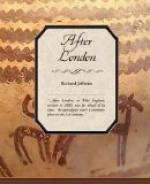This was not broken, but a part of the bark was abraded, and even torn up from the wood as if by the impact of some hard substance, as a stone thrown with great force. He examined the ground, but there was no stone visible, and on again looking at the bark he concluded that it had not been done with a stone at all, because the abraded portion was not cut. The blow had been delivered by something without edges or projections. He had now no longer any doubt that the lesser branch outside had been broken, and the large inside branch bruised, by the passage of a Bushman’s throw-club.
These, their only missile weapons, are usually made of crab-tree, and consist of a very thin short handle, with a large, heavy, and smooth knob. With these they can bring down small game, as rabbits or hares, or a fawn (even breaking the legs of deer), or the large birds, as the wood-turkeys. Stealing up noiselessly within ten yards, the Bushman throws his club with great force, and rarely misses his aim. If not killed at once, the game is certain to be stunned, and is much more easily secured than if wounded with an arrow, for with an arrow in its wing a large bird will flutter along the ground, and perhaps creep into sedges or under impenetrable bushes.
Deprived of motion by the blow of the club, it can, on the other hand, be picked up without trouble and without the aid of a dog, and if not dead is despatched by a twist of the Bushman’s fingers or a thrust from his spud. The spud is at once his dagger, his knife and fork, his chisel, his grub-axe, and his gouge. It is a piece of iron (rarely or never of steel, for he does not know how to harden it) about ten inches long, an inch and a half wide at the top or broadest end, where it is shaped and sharpened like a chisel, only with the edge not straight but sloping, and from thence tapering to a point at the other, the pointed part being four-sided, like a nail.
It has, indeed, been supposed that the original spud was formed from a large wrought-iron nail, such as the ancients used, sharpened on a stone at one end, and beaten out flat at the other. This instrument has a handle in the middle, half-way between the chisel end and the point. The handle is of horn or bone (the spud being put through the hollow of the bone), smoothed to fit the hand. With the chisel end he cuts up his game and his food; the edge, being sloping, is drawn across the meat and divides it. With this end, too, he fashions his club and his traps, and digs up the roots he uses. The other end he runs into his meat as a fork, or thrusts it into the neck of his game to kill it and let out the blood, or with it stabs a sleeping enemy.
The stab delivered by the Bushman can always be distinguished, because the wound is invariably square, and thus a clue only too certain has often been afforded to the assassin of many an unfortunate hunter. Whatever the Bushman in this case had hurled his club at, the club had gone into the willow bush, snapping the light branch and leaving its mark upon the bark of the larger. A moment’s reflection convinced Felix that the Bushman had been in chase of a pheasant. Only a few moments previously a pheasant had flown before them down the track, and where there was one pheasant there were generally several more in the immediate neighbourhood.




